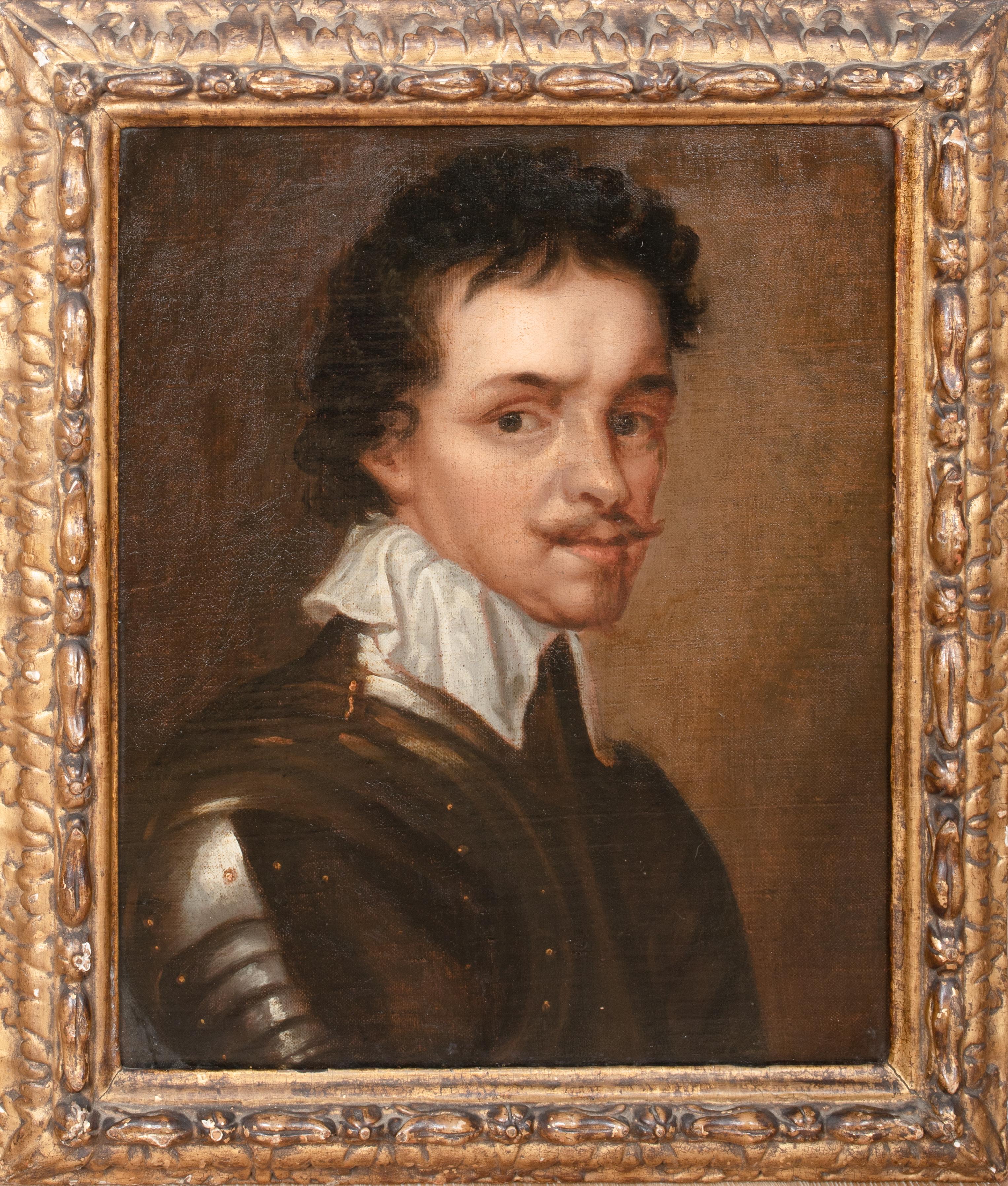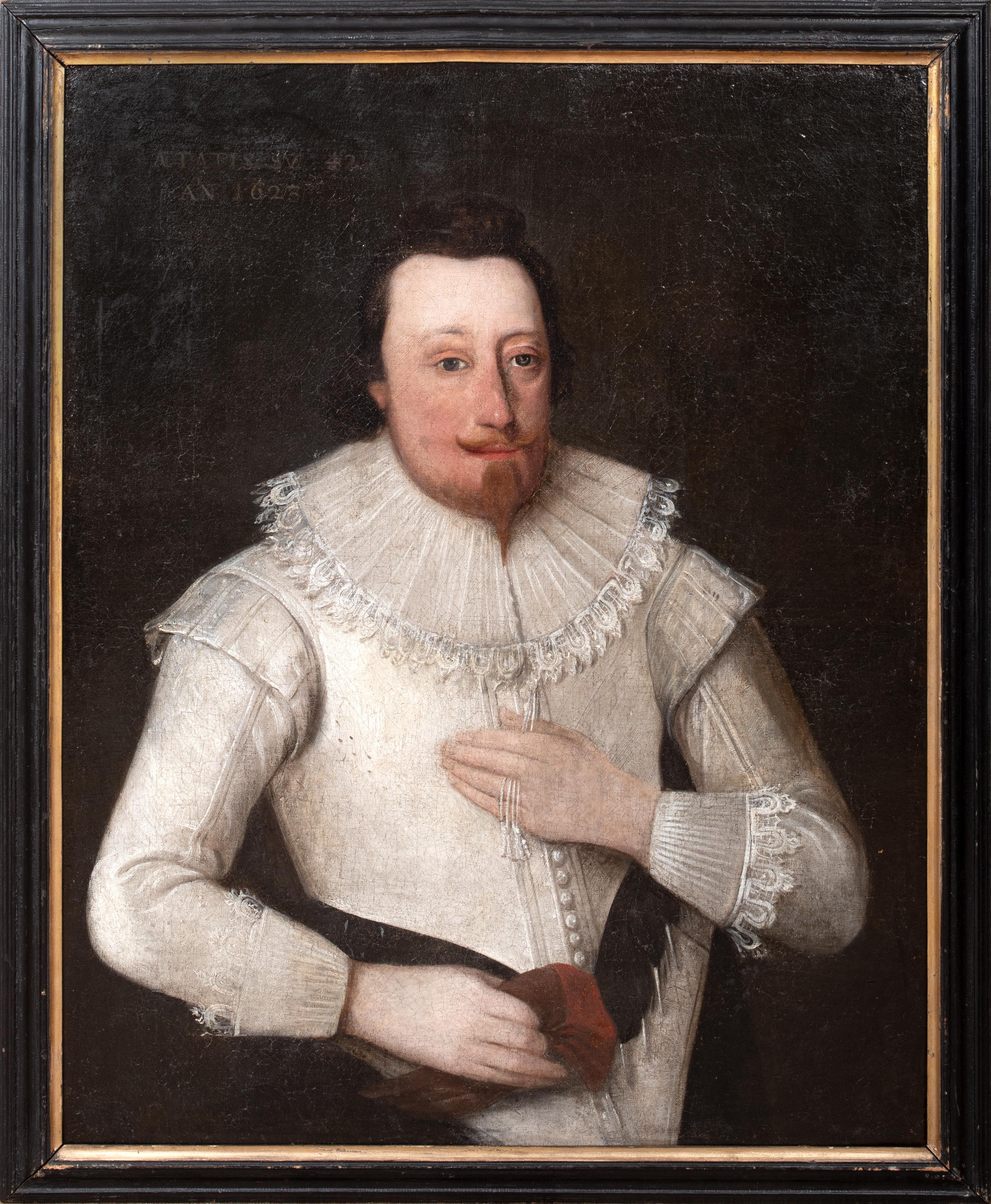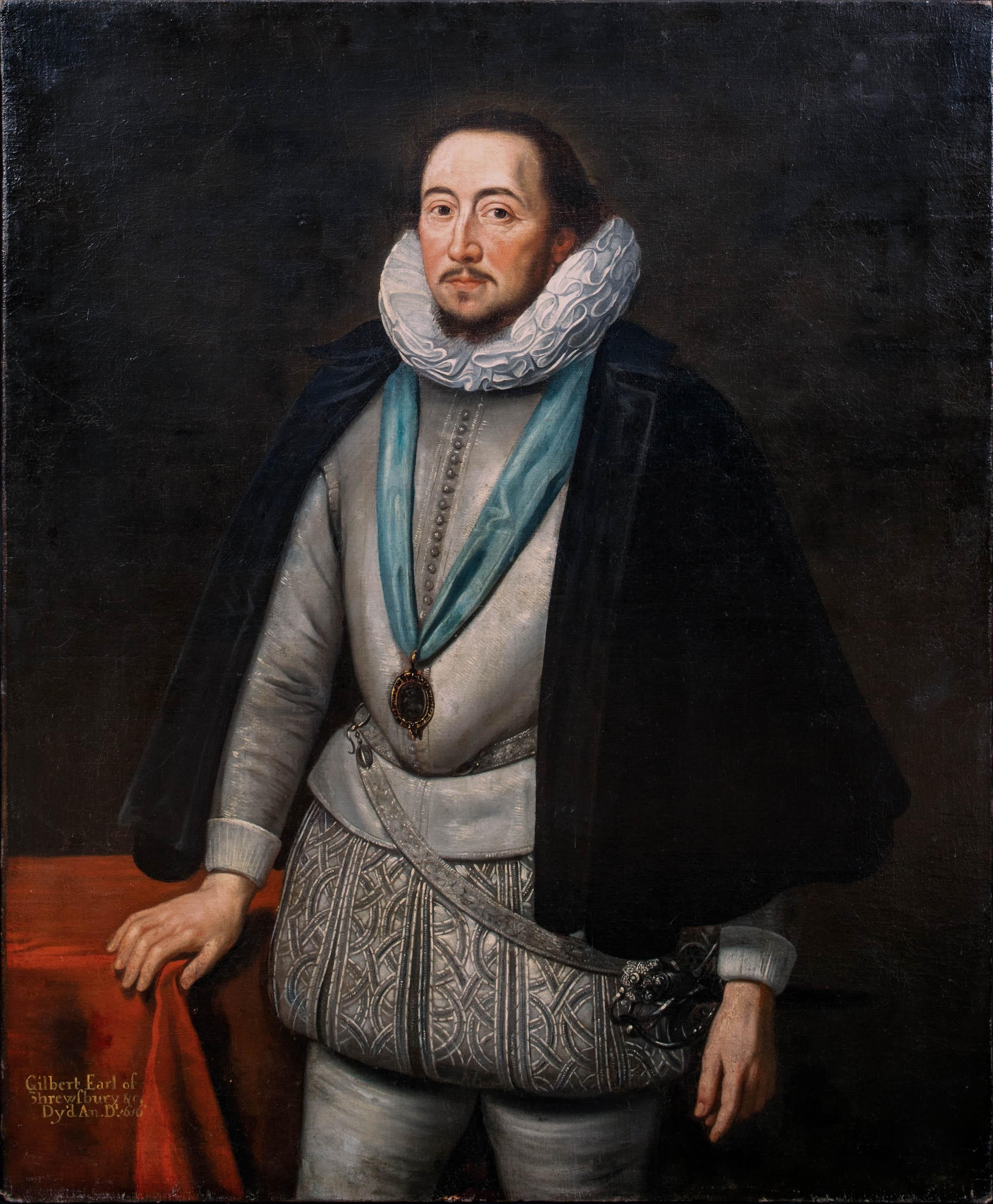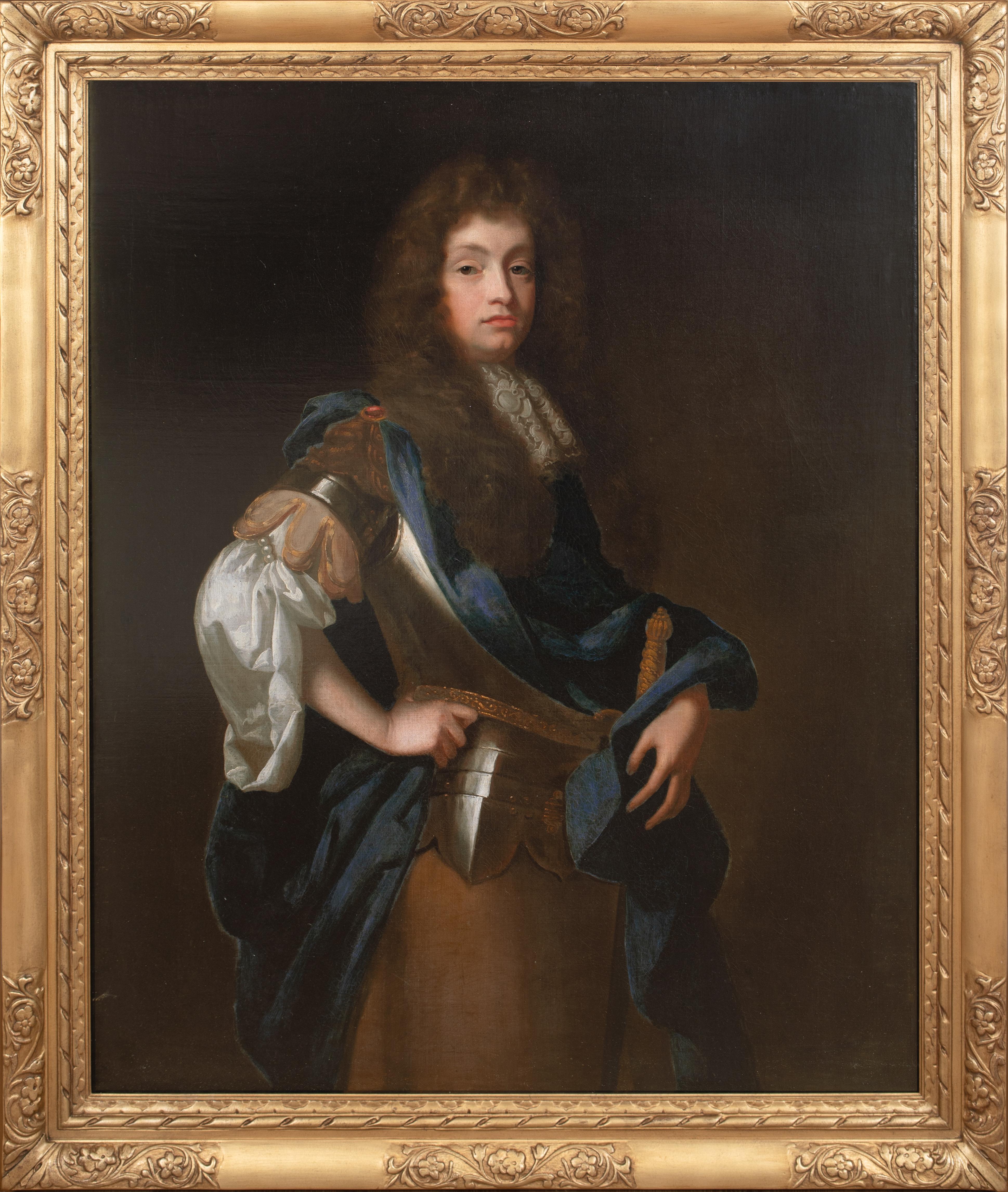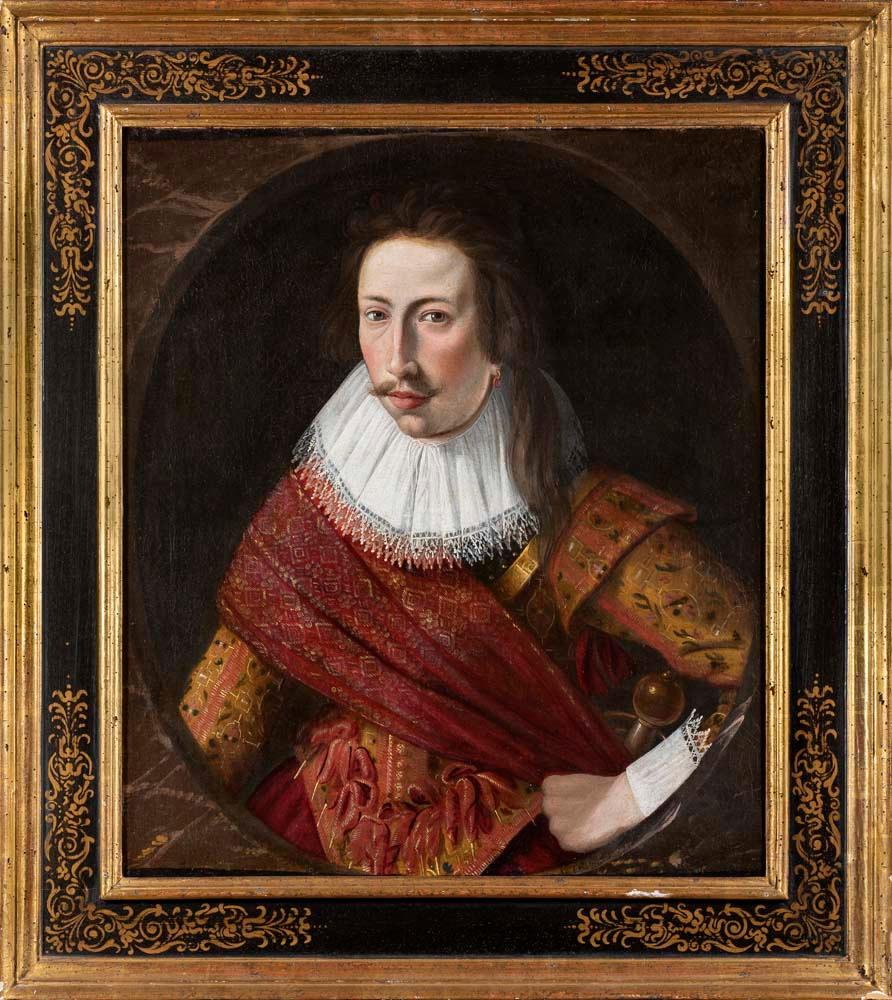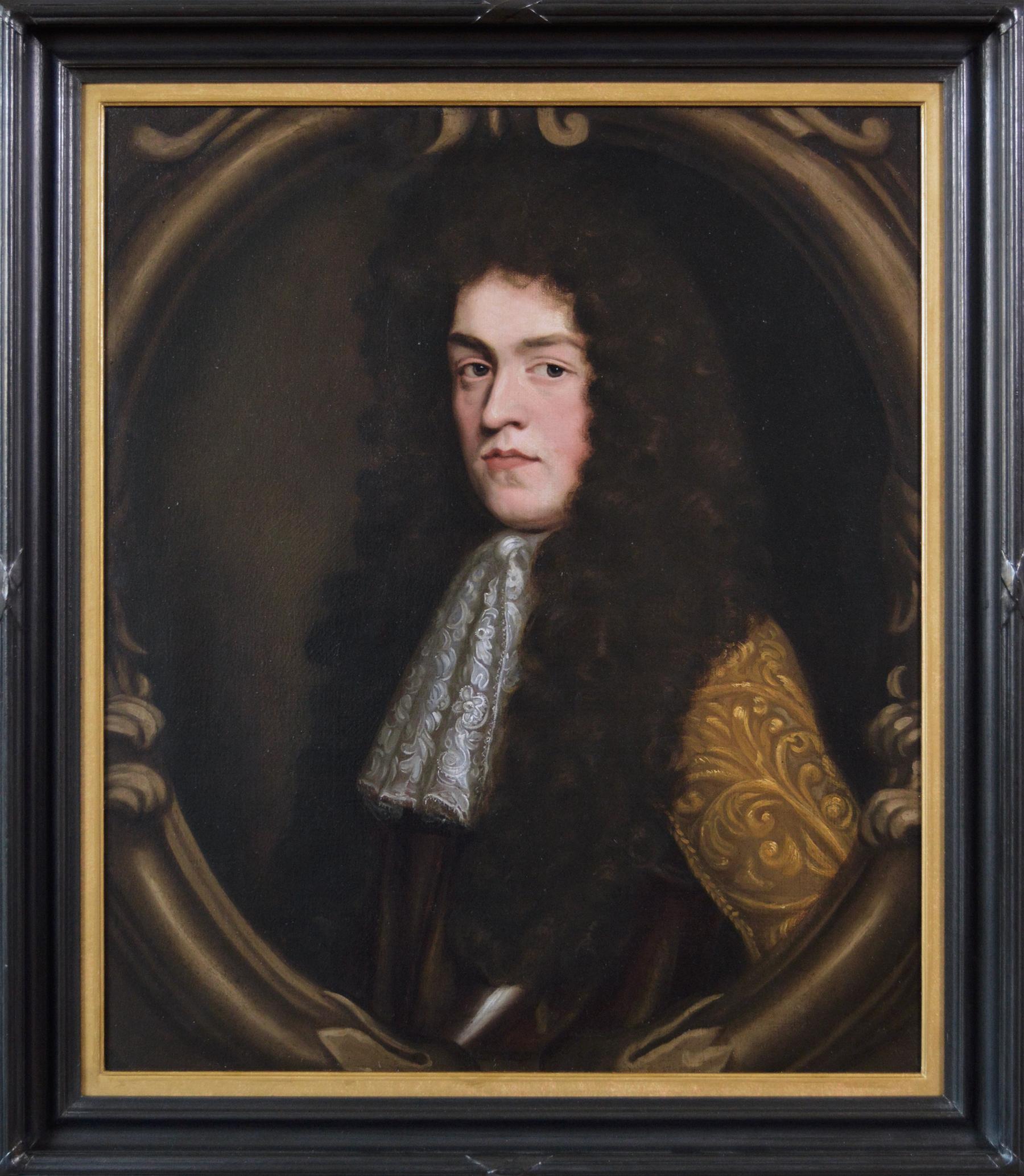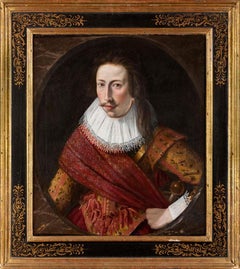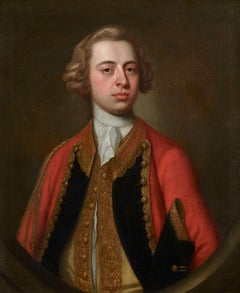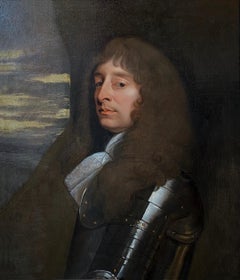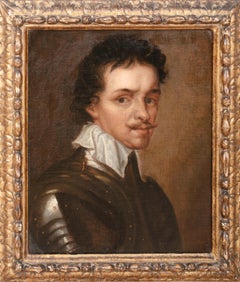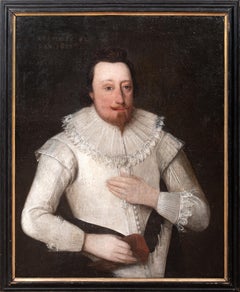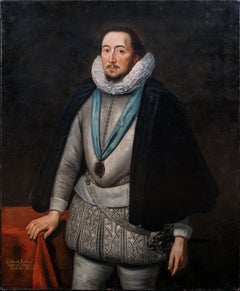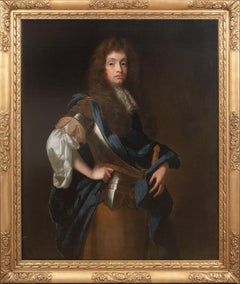Items Similar to Portrait of William Herbert, 3rd Earl of Pembroke, Early 17th Century Portrait
Want more images or videos?
Request additional images or videos from the seller
1 of 9
UnknownPortrait of William Herbert, 3rd Earl of Pembroke, Early 17th Century Portrait1600
1600
$74,445.01
£54,000
€63,058.27
CA$102,933.47
A$113,008.12
CHF 58,956.57
MX$1,367,555.53
NOK 738,929.16
SEK 696,265.54
DKK 470,713.18
About the Item
English School, (circa 1600)
Portrait of William Herbert, 3rd Earl of Pembroke
Oil on panel, oval
Image size: 29¼ x 23⅞ inches
Painted wooden frame
Provenance:
176, Collection of Francis Greville, 1st Earl of Warwick.
The Trustees of the Lord Brooks’ Settlement, (removed from Warwick Castle).
Sotheby’s, London, 22nd March 1968, lot 81.
Painted onto wooden panel, this portrait shows a dark haired gentleman in profile sporting an open white shirt. On top of this garments is a richly detailed black cloak, decorated with gold thread and lined with a sumptuous crimson lining. With the red silk inside it’s all very expensive and would fall under sumptuary laws – so this is a nobleman of high degree.
It’s melancholic air conforms to the contemporary popularity of this very human condition, evident in fashionable poetry and music of the period. In comparison to our own modern prejudices, melancholy was associated with creativity in this period.
This portrait appeared in the earliest described list of pictures of Warwick castle dating to 1762. Compiled by collector and antiquary Sir William Musgrave ‘taken from the information of Lord & Lady Warwick’ (Add. MSS, 5726 fol. 3) is described;
‘8. Earl of Essex – an original by Zuccharo – seen in profile with black hair. Holding a black robe across his breast with his right hand.’
As tempting as it is to imagine that this is a portrait of Robert Devereux, the 2nd Earl Essex, we might take this with a pinch of salt. Its identification with this romantic and fatal Elizabethan might well have been an attempt to add romance to Warwick Castle’s walls. It doesn’t correspond all that well with Essex’s portraits around 1600 after his return from Cadiz. Notably, this picture was presumably hung not too far away from the castle’s two portraits of Queen Elizabeth I. The first, and undoubtedly the best, being the exquisite coronation portrait that was sold by Lord Brooke in the late 1970s and now hangs in the National Portrait Gallery. The second, described as being ‘a copy from the original at Ld Hydes’, has yet to resurface.
The portrait eventually ended up being hung in the State Bedroom of Warwick Castle.
Archival documents present one other interesting candidate. The Greville family’s earliest inventory of paintings, made in 1630 at their home Brooke House in Holborn, London, describes five portraits of identified figures. All five belonged to the courtier, politician and poet Sir Fulke Greville (1554-1628), 1st Baron Brooke, and were hung in the ‘Gallerie’ of Brooke House behind yellow curtains. One of them was described as being of ‘Lord of Pembrooke’, which is likely to have been William Herbert (1580-1630), 3rd Earl of Pembroke. William was the eldest son of Greville’s best friend’s sister Mary Sidney, and was brought up in the particularly literary and poetically orientated household which his mother had supported. Notably, the 3rd Earl was one of the figures that Shakespeare’s first folio was dedicated to in 1623.
The melancholic air to the portrait corresponds to William’s own pretensions as a learned and poetic figure. The richness of the robe in the painting, sporting golden thread and a spotted black fabric, is indicative of wealth beyond that of a simple poet or actor. The portrait’s dating to around the year 1600 might have coincided with William’s father death and his own rise to the Pembroke Earldom. This period of his life too was imbued with personal sadness, as an illicit affair with a Mary Fitton had resulted in a pregnancy and eventual banishment by Elizabeth I to Wilton after a short spell in Fleet Prison. His illegitimate son died shortly after being born. Despite being a close follower of the Earl of Essex, William had side-stepped supporting Devereux in the fatal uprising against the Queen and eventually regained favour at the court of the next monarch James I.
His linen shirt is edged with a delicate border of lace and his black cloak is lined on the inside with sumptuous scarlet and richly decorated on the outside with gold braid and a pattern of embroidered black spots.
Despite the richness of his clothes, William Herbert has been presented in a dishevelled state of semi-undress, his shirt unlaced far down his chest with the ties lying limply over his hand, indicating that he is in a state of distracted detachment. It has been suggested that the fashion for melancholy was rooted in an increase in self-consciousness and introspective reflection during the late 16th and early 17th centuries.
In contemporary literature melancholy was said to be caused by a plenitude of the melancholy humor, one of the four vital humors, which were thought to regulate the functions of the body. An abundance of the melancholia humor was associated with a heightened creativity and intellectual ability and hence melancholy was linked to the notion of genius, as reflected in the work of the Oxford scholar Robert Burton, who in his work ‘The Anatomy of Melancholy’, described the Malcontent as ‘of all others [the]… most witty, [who] causeth many times divine ravishment, and a kind of enthusiamus… which stirreth them up to be excellent Philosophers, Poets and Prophets.’ (R. Burton, The Anatomy of Melancholy, London, 1621 in R. Strong, ‘Elizabethan Malady: Melancholy in Elizabethan and Jacobean Portraits’, Apollo, LXXIX, 1964).
Melancholy was viewed as a highly fashionable affliction under Elizabeth I, and her successor James I, and a dejected demeanour was adopted by wealthy young men, often presenting themselves as scholars or despondent lovers, as reflected in the portraiture and literature from this period. Although the sitter in this portrait is, as yet, unidentified, it seems probable that he was a nobleman with literary or artistic ambitions, following in the same vain as such famous figures as the aristocratic poet and dramatist, Edward de Vere, 17th Earl of Oxford (1550-1604).
The work can also be compared with the portrait of the poet John Donne (c.1595), a rare example of a portrait of a known literary figure from the period, which currently hangs in the National Portrait Gallery. As discussed by Tanya Cooper, this portrait and Donne’s are of a very similar format, both depicting their young sitters in a similar state of melancholic distraction, with their black cloaks wrapped around their shoulders. The similarities between this portrait and that of Donne perhaps indicate the existence of a small sub-genre of portraits depicting aspiring literary figures (see Cooper’s discussion of the work in Cooper, T. Citizen Portrait: Portrait Painting and the Urban Elite of Tudor and Jacobean England and Wales, London, (2012), p.190).
Both paintings contain an unusual wispy vertical white/grey brushstroke, emanating from the sitters’ chests. Elizabethan portraits often contain secret signs and symbols, which told stories about their sitters, and it has been suggested that this mark could represent the vapour of melancholy (see Cooper’s discussion of this feature of Donne’s portrait in Cooper, T. and Eade, J. Elizabeth I & Her People, London, (2014), p.181).
Literature
Cooper, T. Citizen Portrait: Portrait Painting and the Urban Elite of Tudor and Jacobean England and Wales,
London, (2012).
Cooper, T. and Eade, J. (ed.) Elizabeth I & Her People, London, (2014).
Reynolds, A. In Fine Style: The Art of Tudor and Stuart Fashion, London, (2013).
Strong, R. ‘Elizabethan Malady: Melancholy in Elizabethan and Jacobean Portraits’, Apollo, LXXIX,
(1964).
(We are grateful to Adam Busiakiewicz for his assistance researching this work)
- Creation Year:1600
- Dimensions:Height: 29.25 in (74.3 cm)Width: 23.75 in (60.33 cm)
- More Editions & Sizes:1 of 1Price: $74,445
- Medium:
- Movement & Style:
- Period:Early 17th Century
- Condition:
- Gallery Location:London, GB
- Reference Number:1stDibs: LU5244270482
About the Seller
5.0
Vetted Professional Seller
Every seller passes strict standards for authenticity and reliability
Established in 2007
1stDibs seller since 2014
83 sales on 1stDibs
Typical response time: 4 hours
- ShippingRetrieving quote...Shipping from: London, United Kingdom
- Return Policy
Authenticity Guarantee
In the unlikely event there’s an issue with an item’s authenticity, contact us within 1 year for a full refund. DetailsMoney-Back Guarantee
If your item is not as described, is damaged in transit, or does not arrive, contact us within 7 days for a full refund. Details24-Hour Cancellation
You have a 24-hour grace period in which to reconsider your purchase, with no questions asked.Vetted Professional Sellers
Our world-class sellers must adhere to strict standards for service and quality, maintaining the integrity of our listings.Price-Match Guarantee
If you find that a seller listed the same item for a lower price elsewhere, we’ll match it.Trusted Global Delivery
Our best-in-class carrier network provides specialized shipping options worldwide, including custom delivery.More From This Seller
View AllPortrait of an Officer, Cornelius Johnson, 17th Century Old Masters
By Cornelius Johnson
Located in London, GB
Circle of Cornelius Johnson
Circa 1620’s
Portrait of a Officer
Oil on canvas
Image size: 28 x 24 inches
Period style hand made frame
Provenance
Private European Estate
This striking portrait dates to around 1620, as you can see from the images of the sash the detail is very high. The sash is decorated with gold thread and would have cost a small fortune at the time. Sashes were originally developed for a military function (making officers more visible for their men during combat), but soon became a primarily male fashion...
Category
Early 17th Century Old Masters Portrait Paintings
Materials
Oil
Portrait of a Gentleman, 17th Century Dutch Old Masters Oil
Located in London, GB
Circle of Gerard van Honthorst
1592 - 1656
Portrait of a Gentleman
Oil on wooden panel
Image size: 29 x 23 inches
Contemporary gilt frame
Gerard van Honthorst was a Dutch Golden Age...
Category
17th Century Old Masters Portrait Paintings
Materials
Oil, Wood Panel
Portrait of William Henry Kerr, Earl of Ancram, 4th Marquess of Lothian
Located in London, GB
James Fellowes
Flourished 1719 - 1750
Portrait of William Henry Kerr, Earl of Ancram, 4th Marquess of Lothian
Oil on canvas, signed & dated 1747
Image size: 29 1/2 x 24 1/2 inches (75 x 62 cm)
Original gilt wood frame
William Henry Kerr was born a member of the Scottish peerage to William, third Marquess of Lothian, and his first wife Margaret, daughter of Sir Thomas Nicholson of Kemnay, first Baronet. William was styled Master Jedburgh until 1722, when his father was elevated to a Marquessate, after which he was referred to as Lord Jedburgh until 1735. Following his father’s military footsteps, on 20 June 1735 Ancram was commissioned as a cornet to the regiment (11th Dragoons) of his grand-uncle, Lord Mark Kerr. Ancram married Lady Caroline...
Category
1740s Old Masters Portrait Paintings
Materials
Oil
Portrait of a Nobleman in Armour, 17th Century Oil Painting
By Anthony van Dyck
Located in London, GB
Oil on canvas
Image size: 30 x 35 inches (76.25 x 89 cm)
Carved gilt frame
A half-length portrait of a man turned slightly to the left, gazing at the spectator, standing, wearing st...
Category
17th Century Portrait Paintings
Materials
Canvas, Oil
Possible Portrait of William Shakespeare
Located in London, GB
Oil on oak panel
Image size: 17 1/4 x 22 1/4 inches (44 x 56.5 cm)
Period oak frame
This is a portrait of a Tudor gentleman in an open next shirt with one hand raised to his chest. ...
Category
Early 1600s Portrait Paintings
Materials
Oak, Oil
Portrait of Ralph William Grey
By Bartholomew Dandridge
Located in London, GB
Provenance
By descent through the sitter's family to
The Collection of R. W. Vivian-Neal of Poundisford Park, Somerset, from whom acquired by
With Lane Fine Art, UK, where purchased by the present owners in 1996
Literature
'Poundisford Park, Somerset' in Country Life, 22 December 1934, ill.
A.W. and C.M. Vivian-Neal, Poundisford Park, Somerset: A catalogue of pictures and furniture, Taunton 1939, cat. nos. 11 and 13
This is a three-quarter-length portrait of Ralph William Grey in a mole-coloured velvet coat and a long waistcoat of green satin, heavily embroidered in gold. Under his left right hand is a black chapeau bras. He has white doe-skin gauntlet gloves.
Son of William and Ann Grey of Backworth: born 19 December 1707. He married Mary the daughter of William Rawstorne of Newall in 1741 and died 5 November 1786. He was educated at Eaton and Trinity College, Oxford.
Within a year of his birth Mrs Grey died and, according to the Country Life article 'From that time forward all Mr Grey's faculties were concentrated on the well-being of his son. The possession of an heir gave zest to his efforts to build up the family fortune: he was successful in most of his ventures. Years later his interest in life was centred in the home of his daughter-in-law and grandchildren'.
Grey's right hand is depicted in the present portrait resting on Locke's Essays and the Country Life article also records that there are constant references to John Locke...
Category
Mid-18th Century English School Portrait Paintings
Materials
Oil
You May Also Like
Portrait Thomas Wentworth, 1st Earl of Stafford (1593-1641), 17th Century
Located in Blackwater, GB
Portrait Thomas Wentworth, 1st Earl of Stafford (1593-1641), 17th Century
Circle of Anthonius VAN DYCK (1599-1641)
Fine 17th century English School Old Master portrait of Anthonius...
Category
19th Century Portrait Paintings
Materials
Canvas, Oil
Portrait Of A Gentleman, identified as Robert Carr, Earl Of Somerset (1587-1645)
Located in Blackwater, GB
Portrait Of A Gentleman, identified as Robert Carr, Earl Of Somerset (1587-1645), 17th Century
English Court Portrait dated 1625
Large 17th Century English Court Portrait, possibly...
Category
17th Century Portrait Paintings
Materials
Canvas, Oil
Portrait Of Gilbert Talbot 7th Earl of Shrewsbury (1552-1616), 16th Century
Located in Blackwater, GB
Portrait Of Gilbert Talbot 7th Earl of Shrewsbury (1552-1616), 16th Century
Circle of George Gower (c.1540–1596)
Huge 16th Century Portrait Of Gil...
Category
18th Century Portrait Paintings
Materials
Canvas, Oil
Portrait Of Richard Jones, 1st Earl Of Ranelagh, 17th Century SIR PETER LELY
By Sir Peter Lely
Located in Blackwater, GB
Portrait Traditionally Identified as Richard Jones, 1st Earl Of Ranelagh, 17th Century
School Of Sir Peter Lely (1618-1680)
Large 17th Century Portrait believed to be Rochard Jones...
Category
17th Century Portrait Paintings
Materials
Oil, Canvas
17th Century portrait oil painting of a gentleman
By Willem Wissing
Located in Nr Broadway, Worcestershire
Circle of Willem Wissing
Dutch, (1656-1687)
Portrait of a Gentleman
Oil on canvas
Image size: 29 inches x 24.5 inches
Size including frame: 35 inches x...
Category
17th Century Portrait Paintings
Materials
Canvas, Oil
Portrait Of William Yorke (1609-1666), 17th Century
Located in Blackwater, GB
Portrait Of William Yorke (1609-1666), 17th Century
circle of Edward Bower (fl. 1635 – 1667)
Fine large 17th Century English Master portrait of William...
Category
17th Century Portrait Paintings
Materials
Canvas, Oil
More Ways To Browse
Earl Of
Antique White Shirt
Portrait Of Queen Elizabeth I
Elizabeth I
Sister Mary
Portrait Queen Elizabeth
Portrait Of Queen Elizabeth
Elizabeth And James
Warwick Castle
De Vere
Edward De Vere
Antique Salt Pinch
Lord Nelson Painting
Mongolian Oil Painting
Native American Chief Paintings
Officer 18th Century
Oil Painting King Louis
Oil Portrait Woman 1920s
